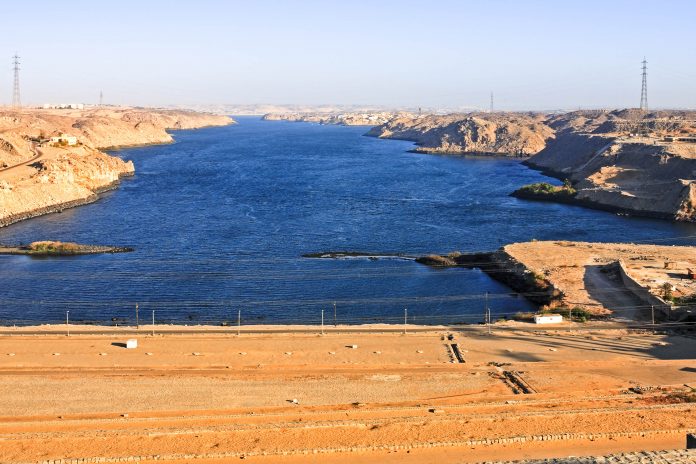Die neue Staumauer des Assuan Staudamms reguliert seit 1971 die Fluten des Nils und staut ihn zu einem der größten Stauseen der Erde auf. Um nicht in den Fluten zu versinken mussten 100.000 Menschen und an die 30 Kulturdenkmäler versetzt werden.
Der Assuan Staudamm, auch bekannt unter Sadd el Ali-Hochdamm, gehört zu unseren Top 10 Sehenswürdigkeiten von Ägypten. Die gigantische Staumauer staut den Fluss Nil zum gigantischen Nasser See, dem in voller Fläche mit 6.000 Quadratkilometern viertgrößten Stausee der Welt.
Inhaltsverzeichnis
Errichtung des Assuan Staudamms
Das Problem mit dem Nil ist ja bekannt. Dürre und Flut wechselten mit den Launen des riesigen Flusses, biblische Plagen kamen über Ägypten. Der erste Versuch, den Nil zu zähmen wurde mit dem etwa 2km langen alten Staudamm unternommen. Dieser wurde knapp 10km südlich von Assuan durch eine britische Firma aus Granit errichtet und im Jahr 1902 fertig gestellt. Über 180 Schleusen konnte das Nilwasser reguliert die Staumauer durchbrechen und brachte so den für die Landwirtschaft notwendigen fruchtbaren Nilschlamm.
In den weiteren 30 Jahren wurde er bis auf 54 Meter erhöht. Dies reichte jedoch noch immer nicht aus, die gewaltigen Wassermassen des Nil in Schach zu halten. Und so entstand im Jänner 1960 etwa 7km südlich der alten Staumauer der heute bekannte Assuan-Hochdamm.
Finanziert wurde der Bau durch die Einnahmen aus dem Suezkanal, den der damalige Staatspräsident Gamal Abd el Nasser kurzerhand verstaatlichte (und damit zur Entstehung der Suezkrise beitrug), sowie mit Unterstützungsgeldern der damaligen Sowjetunion.
Elf Jahre nach Baubeginn wurde der knapp 4km lange Assuan Staudamm offiziell eröffnet – dazu reiste sogar der russische Regierungschef Nikita Chruschtschow an. An die russisch-ägyptische Zusammenarbeit erinnert ein beeindruckendes Denkmal auf dem Damm in Form einer Lotusblüte, die ein Zahnrad umschließt. Von einer Aussichtsplattform auf 74 Metern Höhe kann man das imposante Panorama aus Staudamm, See und Wüste überblicken.
Der Assuan Staudamm in Zahlen
| Kosten | 2,2 Milliarden Euro |
| Bauzeit | 11 Jahre |
| Länge | 3,8 Kilometer |
| Breite von unten nach oben | 980 bis 40 Meter |
| Höhe | 111 Meter |
| Beteiligte Arbeiter | Etwa 30.000 |
| Todesfälle während des Baus | 451 |
Die negativen Seiten des Assuan Staudamms
Der Bau war – wie jedes große Vorhaben der Geschichte – nicht unumstritten. Erstens mussten an die 100.000 Menschen, überwiegend Nubier, umgesiedelt werden. Und zweitens waren auch einige Denkmäler der ägyptischen Kultur durch die Fluten des entstehenden Stausees bedroht.
Insgesamt mussten 29 Tempel in aufwändigen Projekten unter Zusammenarbeit der UNO, UNESCO und der ägyptischen Regierung vor der Zerstörung gerettet werden – die spektakulärste Verlegung war sicher jene der gewaltigen Tempelanlage von Abu Simbel. Als Dank für die internationale Hilfe steht nun der Tempel von Debod in der spanischen Hauptstadt Madrid und der Tempel von Dendur im New Yorker Metropolitan Museum of Art. Dennoch wurden einige der bedrohten Kulturgüter sowohl ägyptischer als auch nubischer Kultur nicht versetzt und sind nun für immer verloren.
Ein weiterer Nachteil des Dammbaus ist der nun ausbleibende Nilschlamm. Die Wasserzufuhr ist zwar nun reguliert und nicht mehr saisonabhängig, doch die Bauern sind nun gezwungen, ihre Felder mit Hilfe von Kunstdünger zu bewirtschaften, was sich immer wieder negativ auf den Säuregehalt des Bodens auswirkt.
Die fehlenden Nährstoffe reduzierten den Fischbestand, was die Fischindustrie sogar noch im Mittelmeer zu spüren bekam. Mittlerweile ist der Fischfang streng reguliert und die Bestände erholen sich langsam wieder. Durch den aufgestauten Nilschlamm versandet dafür der Nasser See immer mehr. In schätzungsweise 500 Jahren wird er kein Wasser mehr aufnehmen können.





